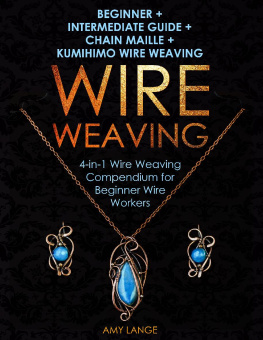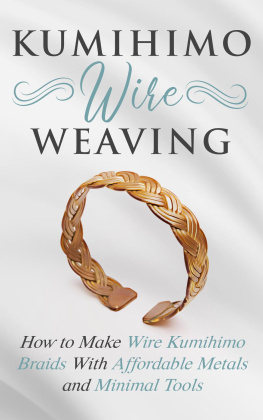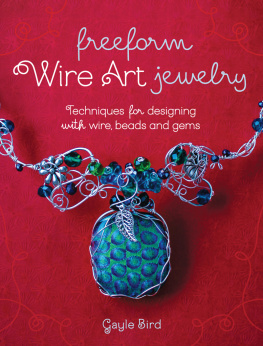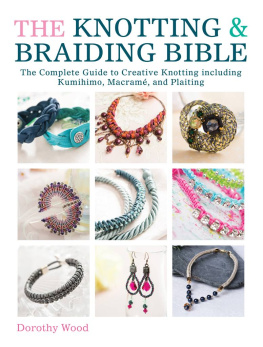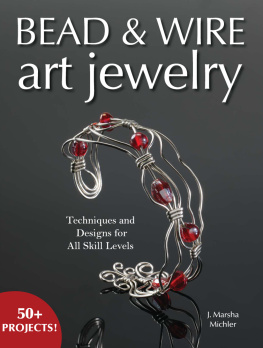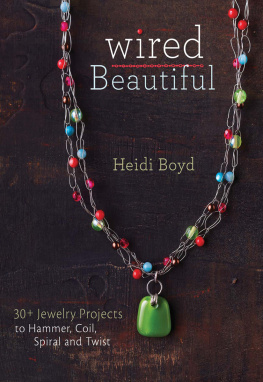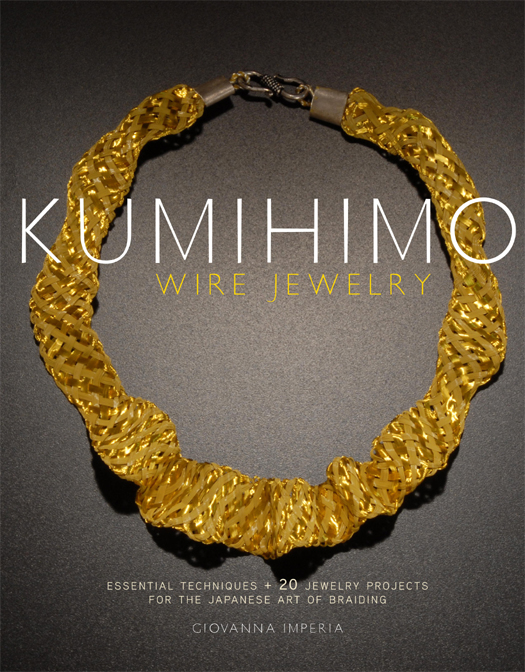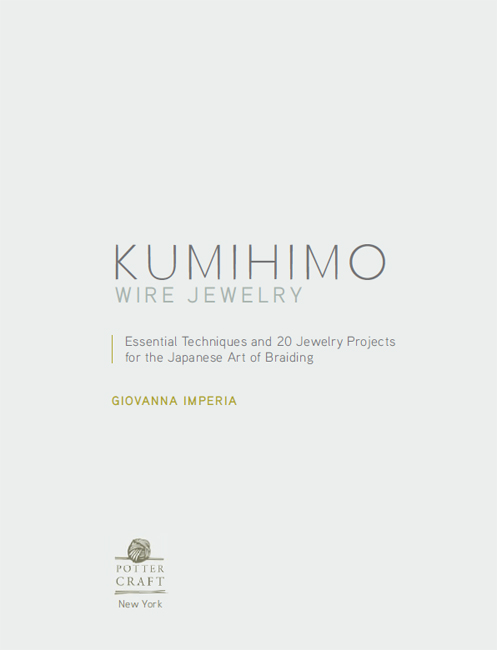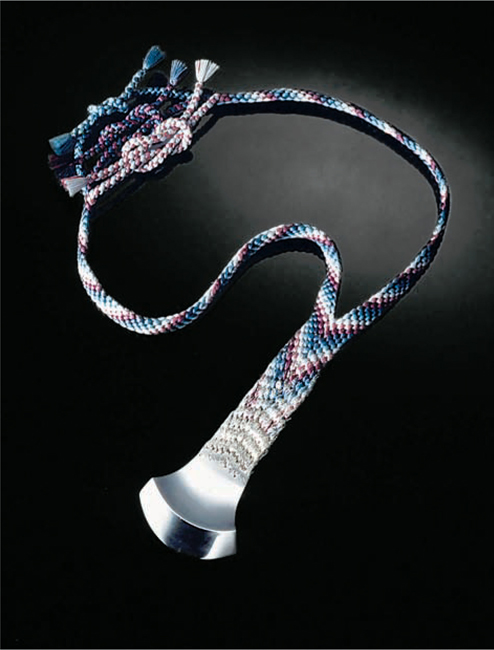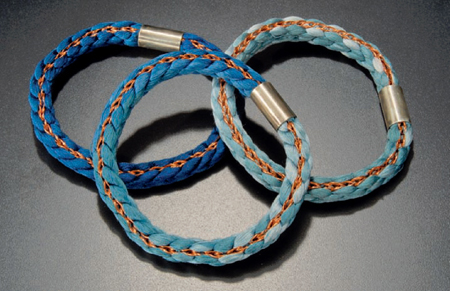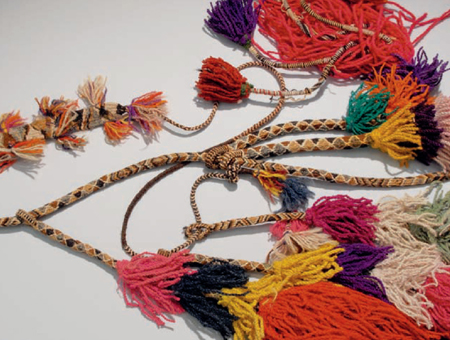Necklace by Giovanna Imperia.
Text and illustrations copyright 2011 by Giovanna Imperia.
All photographs by Jack Zilker, copyright 2011 by Potter Craft, except for by Michael Hattori.
Published in 2011 by Potter Craft, an imprint of the Crown Publishing Group, a division of Random House, Inc., New York
www.crownpublishing.com
www.pottercraft.com
POTTER CRAFT and colophon is a registered trademark of Random House, Inc.
Library of Congress Cataloging-in-Publication Data
Imperia, Giovanna.
Kumihimo wire jewelry : essential techniques and 20 jewelry projects for the Japanese art of braiding / Giovanna Imperia.
p.cm.
Includes index.
Trade paperback ISBN 978-0-8230-8551-4
eBook ISBN 978-0-8230-2717-0
1. Jewelry makingJapan. 2. Wire craftJapan. 3. BraidJapan. I. Title.
TT212.I55 2011
739.270952dc22
2010013083
All rights reserved.
This book contains general instructions and techniques on making jewelry from wire and fiber. When working with the tools and materials presented in this book, readers are strongly cautioned to use proper care and judgment, to follow the applicable manufacturers directions, and to seek prompt medical attention in case of an injury. In addition, readers are advised to keep all potentially harmful materials away from children. The author and the publisher expressly disclaim any liability, loss, or risk, personal or otherwise, which is incurred as a consequence, directly or indirectly, of the use and application of any of the contents of this book.
v3.1
DEDICATION
There are many people I would like to thank for their support and faith in this project starting with the kumihimo artists who graciously agreed to contribute some of their work. Without their contributions this book would not have been as exciting:
Shirley Berlin (United Kingdom)
Dominique Brochard (France)
Edna Gibson (United Kingdom)
Michael Hattori (United States)
Anna Hurwitz (United Kingdom)
Sandy Jassett (United Kingdom)
Carole MacAllister (United Kingdom)
Leigh Morris (New Zealand)
Aya Nakayama (Japan)
Maristella Ornati (Italy)
Makiko Tada (Japan)
A special thanks to Pat Powell (United States) and Lidia Musetti (Italy) who also contributed two projects.
I am also thankful to my friends and sensei Rodrick Owen, Makiko Tada, and Masako Kinoshita for their wonderful input and moral support.
I am deeply grateful to my editors, Joy Aquilino and Martha Moran; my photographer, Jack Zilker, and my graphic designer, illustrator, and daughter, Cristina Cook. Without their tireless work, direction, assistance, and guidance this book would not have been possible.
Last but not least, I would like to thank my husband, Lance Cook, who has supported me throughout the many months of hard work.
Giovanna Imperia
Necklace by Aya Nakamaya. For this necklace, Aya Nakayama used a method she developed to harmoniously blend the silver wire into the silk. The result is a seamless flow from the cast centerpiece to the braided wire to the braided silk.
CONTENTS
Bracelets by Giovanna Imperia.
PREFACE
While kumihimo has been around for many centuries, new interest in it has surged in Japan and the West over the last twenty years. Many books have been written on the subject and they have helped popularize the technique, making kumihimo more accessible by presenting technically rigorous information in a user-friendly way. Most recently, many small project oriented books have emerged in the United States, all of which, unfortunately, lack the technical knowledge and expertise of the earlier books. This suggested to me the need for a new type of book: A book that would address readers desires for easy-to-follow projects without compromising on what I consider an essential technical foundation. With these essential techniques, I provide a framework that will help you develop an understanding of basic braid structures in a way that gives you the creative freedom to develop more complex braid structures on your own. By combining these two elementsessential techniques and projectsthis book provides more comprehensive coverage than others and can be used by experienced and novice braiders alike.
Equally important, this is the first kumihimo book on braiding with wire. While wire can be used on any of the traditional kumihimo stands, for this first book on the subject I chose to focus on twenty gorgeous, one-of-a-kind projects for the disk/Maru Dai and the square plate.
The projects in this book, as well as many of the contributions from other artists, represent a radical departure from traditional applications of kumihimo and offer a contemporary view of braided jewelry. The instructions are designed to be clear, concise, and easy to follow, and the contributions from other artists will intrigue and inspire you.
GIOVANNA IMPERIA
INTRODUCTION
Braids are common in many cultures, where they have served a wide range of functionsfrom practical applications to decorations on garments to key elements in religious ceremonies. Some braiding traditions developed independently in different regions, which led to the emergence of unique designs and structures. Some braiding traditions developed as a result of cultural migration. A good example of the latter is the development of kumihimo in Japan.
There are also many different processes that are used in braiding. Some braids are made without the aid of tools. Other braids are made using a stand, typically round, and weighted bobbins. Among the cultures using stands, Japan is unique in that braids are made using a number of specialized stands, not just a round one.
An example of a contemporary Peruvian sling braid, a practical braid application. Note the various braid structures used throughout and the colorful tassels, which are added afterward.
A BRIEF HISTORY OF KUMIHIMO
The term kumihimo means intersected threads. It refers to any type of braid executed using the loop-manipulation method (which does not require equipment) or any number of stands.
Kumihimo has very long history in Japan, where some early examples of impressions of braided structures on pottery date back to the Jomon period (8000300 BC). By the Kofun period (4th6th centuries), braids had become common thanks in large part to the diffusion of Buddhism. According to research by Masako Kinoshita, many of the early braids, such as the ones in the Shosoin treasure house (Nara period, AD 645784), were probably executed using the loop-manipulation braiding technique.
Over the centuries, kumihimo became an integral part of the Japanese culture, where it assumed uses that ranged from the functional (such as ties for prayer scrolls or as lacing devices for the samurai armor, which required nearly three hundred silk braids) to the decorative (such as embellishments for Buddhist statues and rosaries as well as obijime, a narrow braided belt that holds the much wider obi in place). Because of its role in Japanese culture, over time, many different pieces of equipment were developed, which helped artisans produce braids faster and of consistent quality while developing new and more complex structures and designs. Automated machines, developed later in the Meiji period (18671912), allowed for even faster production. These machines are still in use today, as are five braiding stands: the Maru Dai, Taka Dai, Karakumi Dai, Kaku Dai, and Ayatake Dai.



